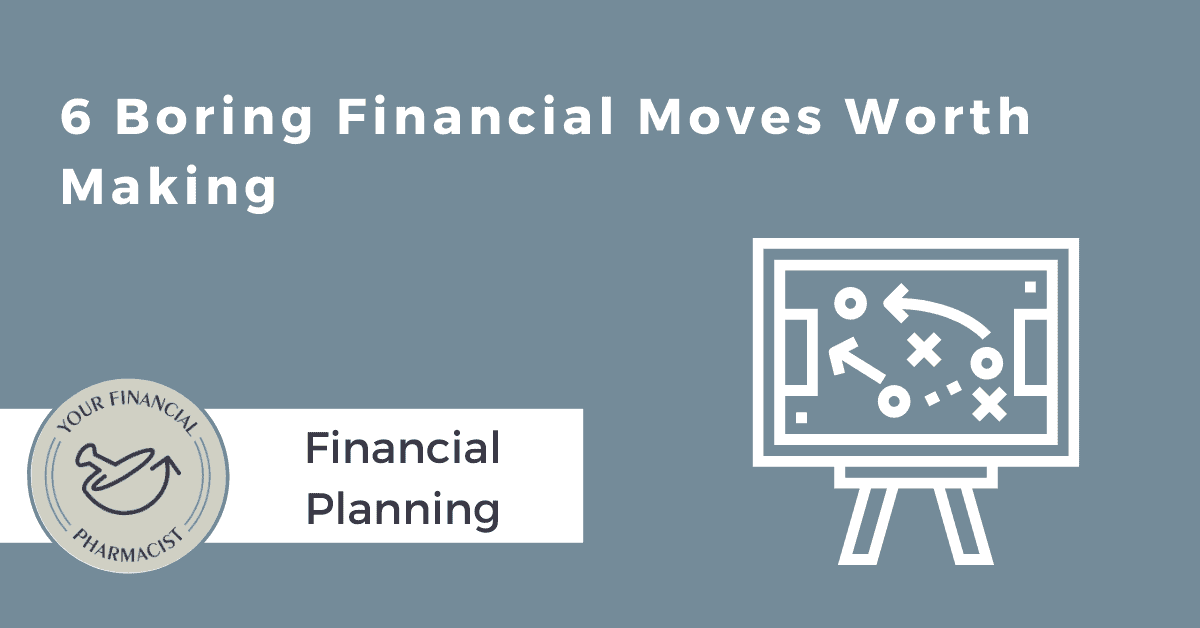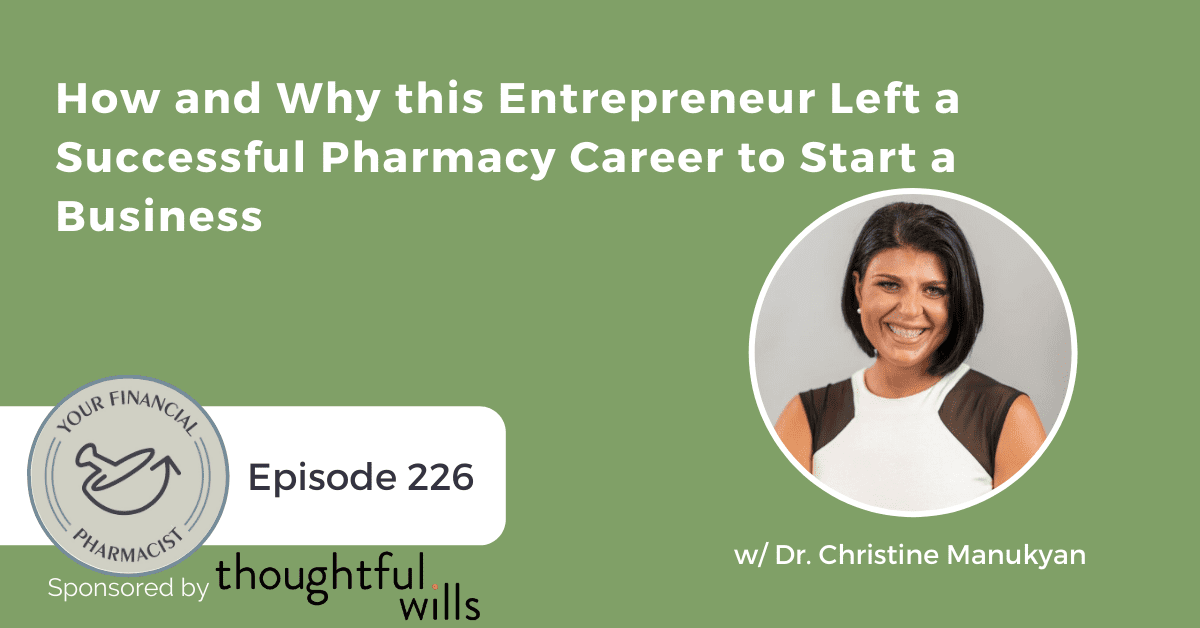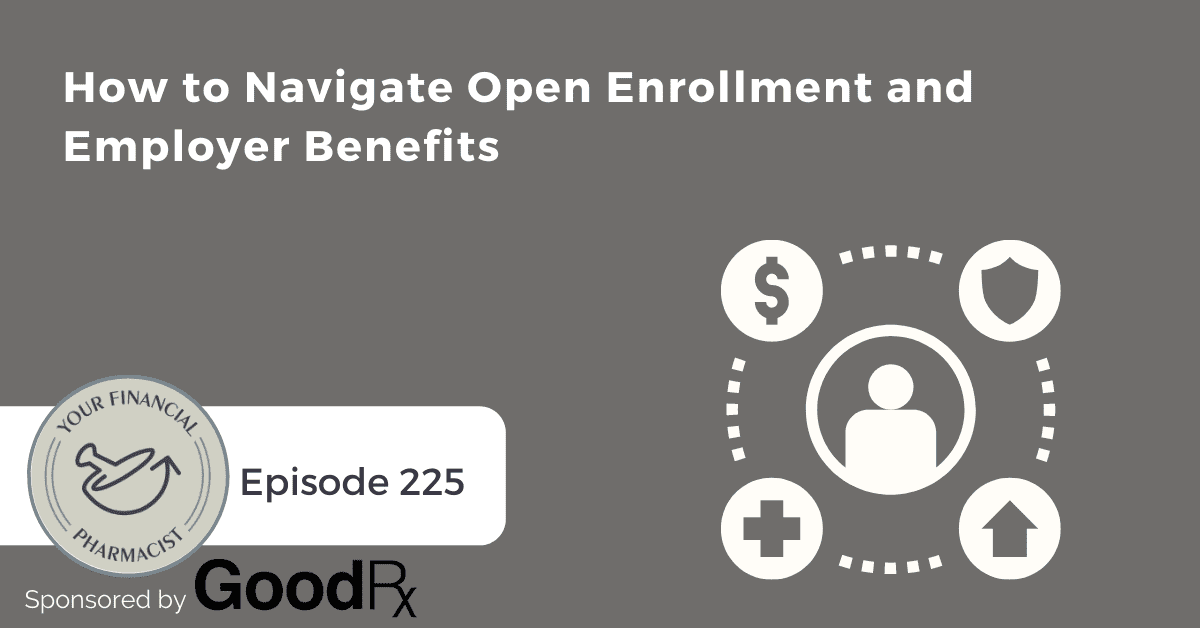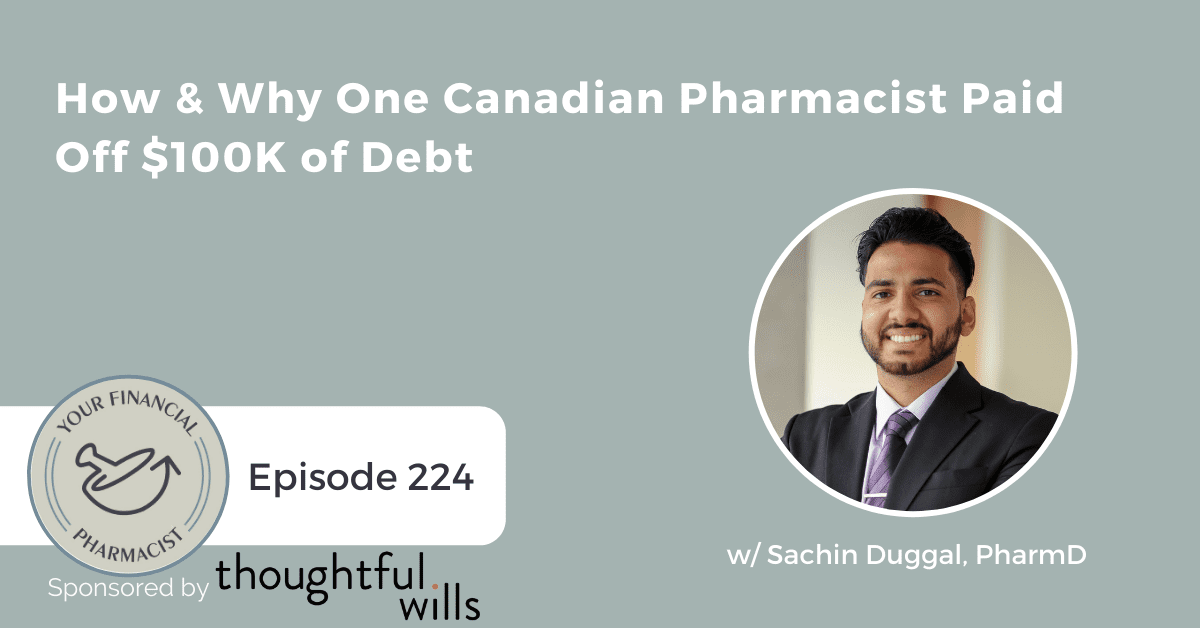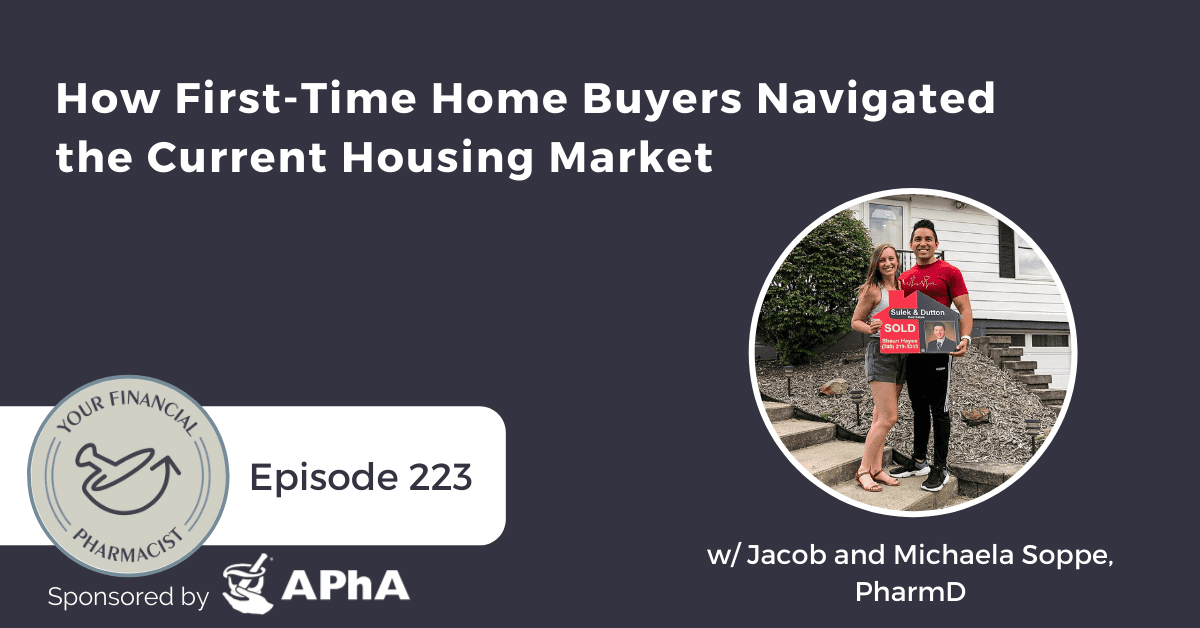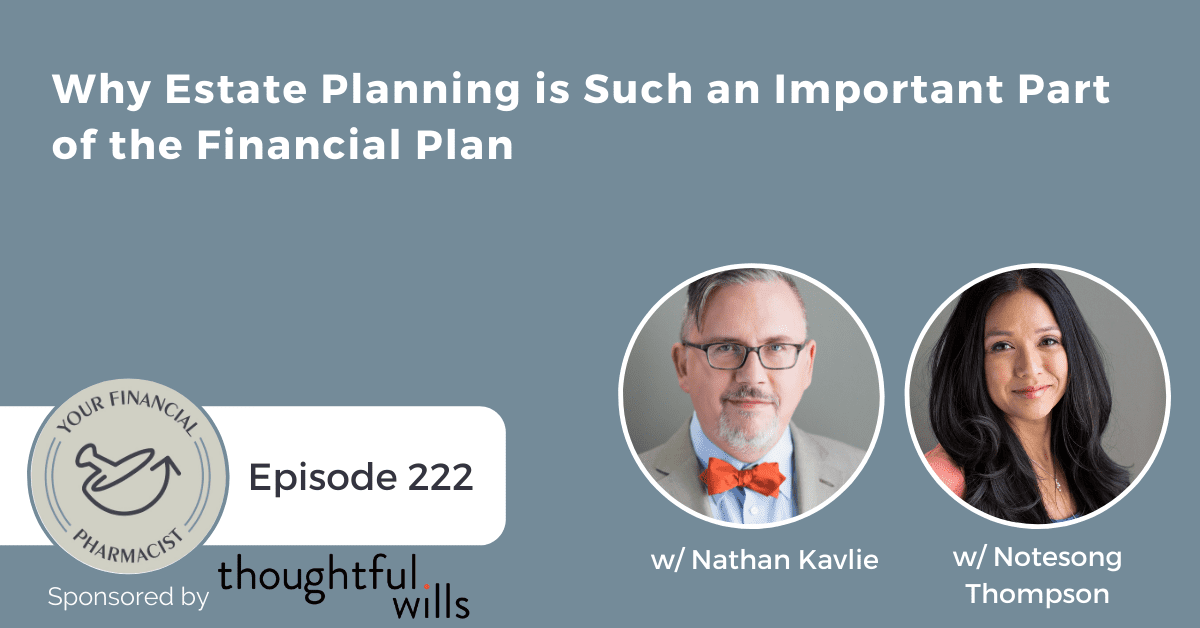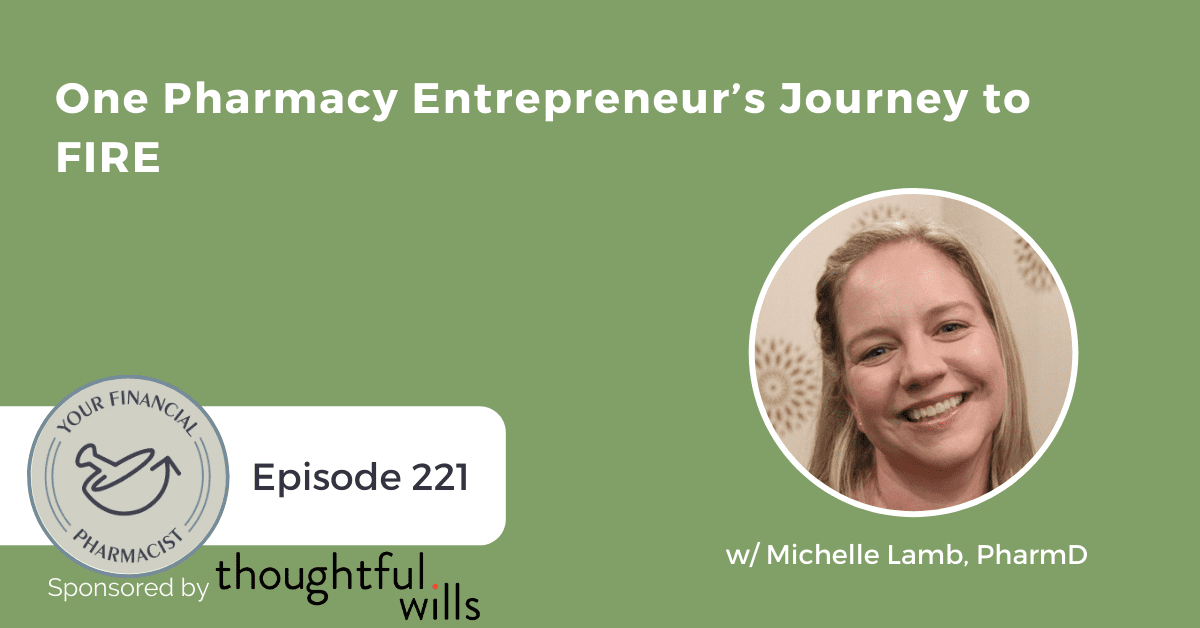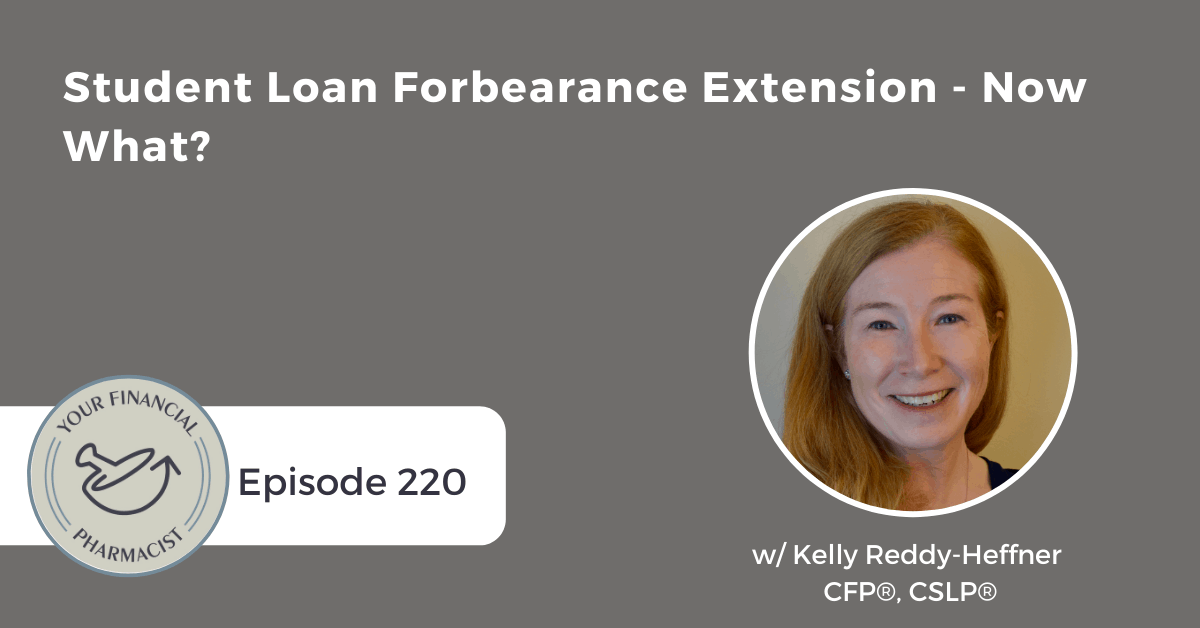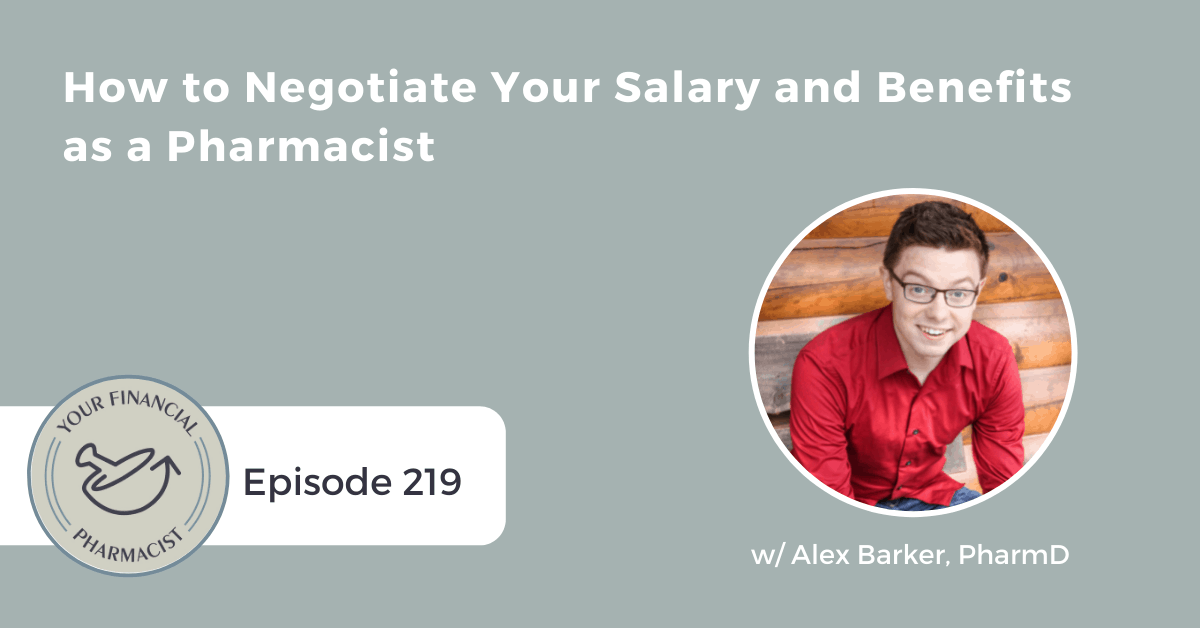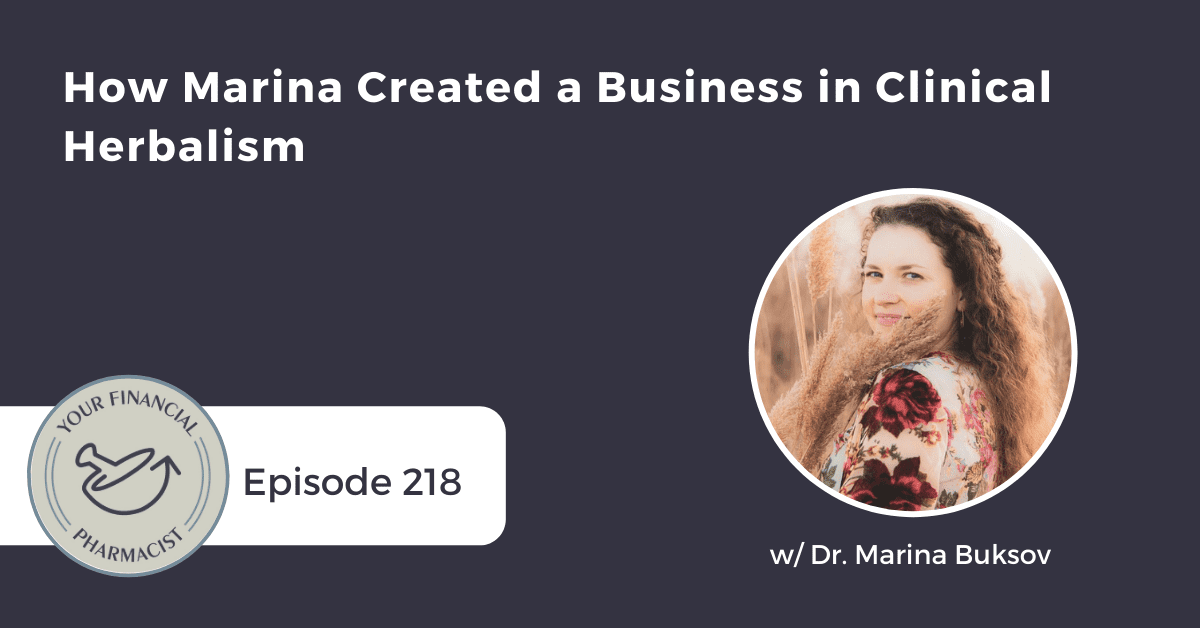How First-Time Home Buyers Navigated the Current Housing Market
On this episode, sponsored by APhA, Jacob and Michaela Soppe discuss their home buying journey in the current real estate market.
About Today’s Guests
Jacob and Michaela are graduates of Ohio Northern University who moved to eastern Ohio in 2018 so that Jacob could pursue his dream of starting a pharmacy with Southeast Healthcare. Since then, he has successfully grown his pharmacy and offers clinical services including diabetes and hepatitis C clinics. Michaela works at East Ohio Regional Hospital where she collaborates with doctors and patients in the inpatient, outpatient, and long-term care settings. In their spare time, they love to stay active and travel the world. They recently bought their first home and are excited to continue to serve God and their patients in their community.
Summary
In this episode, Tim Ulbrich turns the microphone over to Nate Hedrick, The Real Estate RPh and co-host of the YFP Real Estate Investing Podcast, as he interviews two pharmacists, Michaela and Jacob Soppe, about their home buying journey. Michaela and Jacob share their experience working with YFP’s Real Estate Concierge, their home search, how they determined their home buying budget, and the realities of buying a home in the current real estate market.
Jacob and Michaela weren’t necessarily looking for a home after pharmacy school and focused their energy and funds on paying down student loans and investing. When they were ready to start the home buying process, they didn’t know what to do or how to start, so they contacted Nate Hedrick and started working with the Real Estate Concierge Service. Nate paired the couple with a real estate agent in their area who worked with them diligently until they found a home that met their budget requirements and exceeded their expectations on must-have items like room for a family and plentiful parking.
The couple shares their experience receiving regular emails with listings and changes to the housing market, a day with nine house viewings, their experience with their home inspection, and how their experience at closing differs from what many folks will see in the current market.
Mentioned on the Show
Episode Transcript
Nate Hedrick: Hey, Michaela, Jacob, welcome to the show.
Jacob Soppe: Thanks for having us.
Michaela Soppe: Yeah, thank you for having us.
Nate Hedrick: Absolutely. Excited to chat today. We are talking all things real estate. I’m taking over the Tim and Tim show here on the Your Financial Pharmacist podcast so we can talk a little bit more about real estate today. So again, appreciate you guys joining us.
Michaela Soppe: Absolutely.
Nate Hedrick: So we are here to talk a little bit about navigating the current housing market, right? So you guys are first-time home buyers, just closed about two months ago on your first house, and what we thought we would do is kind of sit down and talk a little bit about that, talk about what it’s like to buy a house in the current market, what it’s like to be a first-time home buyer, how you guys navigated that, and just kind of get that information in front of people. So before we dive too deeply into the real estate side of things, maybe give us a little bit of background on your pharmacy journey so far and kind of what you guys are up to.
Jacob Soppe: I graduated in 2018, and I immediately got a job on rotations. I met with one of my preceptors and they wanted to open a pharmacy, and they wanted me to open it for them, and that’s something I’m interested in, and so I opened it. That was three years ago. And we’re continuing to grow, and I’m very happy with it. We’re a clinic pharmacy, but we also do long-term care, we also do diabetes clinics, and we’re just starting up Hepatitis C clinics.
Nate Hedrick: That’s great.
Michaela Soppe: So I graduated in 2019. We both graduated from Ohio Northern. And we actually got married while I was on rotations, so he’d basically said, “Hey, how do you feel about moving an hour and a half away from Columbus?” I’m like, “OK, that’s great. But I have rotations in Columbus.” So I started working with Rite Aid after I graduated as a pharmacist and kind of floated all over the place because we didn’t really know where we’d be living for sure. And then worked with them for a couple years and at the end of that, in January, I got a job working at a local hospital. So I do mostly inpatient, but I also have a mix of some outpatient stuff and long-term care in there with that as well. So I’m kind of running all over the place. But I love it.
Nate Hedrick: That’s great.
Michaela Soppe: And we finally made it out closer to where Jacob works. So.
Nate Hedrick: That’s nice, especially when, you know, you’ve already got long days at the hospital or at the pharmacy, you don’t want to add an extra long commute to that. So that’s great.
Michaela Soppe: Exactly.
Nate Hedrick: And when you guys graduated from pharmacy school, I know it was different years, but when you graduated, was buying a house kind of always in that mix? Was it always part of the “next step?” Or was this something that came along later?
Jacob Soppe: We knew we wanted to buy a house eventually, but there was student loans in the way that kept me up at night.
Nate Hedrick: Sure.
Jacob Soppe: And I was like, I can’t buy a house until I pay off these, we pay off these loans. And so after about two years, we paid off the loans and that’s when we started looking for a home.
Michaela Soppe: Yeah, it was definitely student loans first and then, you know, it all worked out around the same time where my job brought us instead of an hour and a half away for Jacob, it’s now five minutes away. And at that point, we were like, OK, like we’re ready to find a house because we’re going to be out here for a while.
Nate Hedrick: Wow, yeah. So I know I’ve talked to others who have that feeling of like, man, I cannot buy until these are gone. And so you guys took that and said, yeah, let’s make sure that’s the case. Let’s go all in on the loans and then once that’s done, then we’ll go ahead and buy a house. Do you feel like that was crippling at all? Was it just like, this is what we have to do to get it done?
Jacob Soppe: It was definitely the second one there. We just felt like we had to do it and felt like it was the right way to go for us.
Nate Hedrick: Yeah.
Michaela Soppe: Yeah, it was kind of like, let’s still act like we’re college kids for a couple years, you know, not buy a bunch of brand new stuff. Like most of our stuff came from our families or stuff I had from college. And so until the loans were gone, we didn’t really spend much money on anything else. Like we’d go traveling, but other than that, it was just loans completely. Like our entire paychecks went to it, basically.
Nate Hedrick: Yeah, avoiding that lifestyle creep can be a really great way to get ahead and make sure that those loans could be knocked out first. So that’s awesome. Were there any other factors that were holding you guys back? I mean, was the market something that scared you? Or talk to me a little about that too. Was it just the student loans and once those were gone, you were ready to move?
Jacob Soppe: The other thing that was holding us back was, like I said earlier, I was driving an hour and a half one way to work each day, so a total of three hours when we started and Michaela was still in school. We wanted to see where she was going to end up working and then when she ended up moving closer to my work, it worked out because it was like just after we paid off our loans. So we didn’t end up looking for a house at our old employer where I was still driving 45 minutes, and I really liked the idea of living like right next to work and the gym and church — and we’ll get into that later.
Michaela Soppe: I guess something I should say is that we moved four times in three years.
Jacob Soppe: Yeah.
Michaela Soppe: And progressively each time, every time my position changed, basically, going from rotation student to floater at Rite Aid to actually having a store at Rite Aid to getting the job at the hospital. Basically every single time, we moved closer and closer to where Jacob was working. And now, it definitely just where are we going to be settled was kind of like a factor that was holding us back slightly too because like my goal was always to get a job closer to where Jacob was working but just we didn’t know when that would happen. And it ended up being at a really convenient time for us.
Nate Hedrick: That’s great. And that actually, that’s a good segue because one of the things I want to talk about today is choosing the location and some of the steps that go into that kind of getting ready phase of buying a home. And that’s actually Step No. 1 of six steps that we’re going to talk about today. So we put together a video series — and actually, there’s a guide out there, we can link to that in the show notes. But if you head on over to YourFinancialPharmacist.com, we have the “Six Steps to Home Buying.” And what I’d like to do is actually walk through each one of those steps and kind of get your take and your experience as first-time home buyers and see what information we can share with our audience. There’s a lot of people that are probably in your shoes or who are about to be in those shoes here pretty soon where they’re graduating, they’ve got a lot of student loan debt, or they’re ready to buy a home, and now it’s time to figure out, OK, what does that actually look like? And more importantly, how do I do that in this kind of market? Because it is quite the seller’s market. It’s very competitive out there. And so trying to get a home today is more difficult than it’s been before. So we’ll start with the first step, which is making sure you’re ready. A lot of this step includes things like choosing a location, determining what is important to you guys, and also setting a budget and not letting the bank set the budget necessarily, not just going out and asking for the biggest loan we can get but setting our own budget. And so when you guys sat down and said, “OK, we need to figure out if we’re ready,” what did that look like? Was it a formal process for you or was this like, I don’t know, I’ve been on Zillow, let’s go take a look. You know, what was that like for you guys?
Michaele Soppe: There was definitely a lot of Zillow involved. So before we made our final move here closer to work, the apartment we were at, we were initially looking for houses there because it seemed like a good, you know, central location at the time when I was with Rite Aid still. So I think Jacob was on Zillow every single day, just you know, browsing houses for probably half a year or so at least and then continuing once we did move a little bit closer into another apartment, like OK, now we’re getting serious. What are we looking at? It wasn’t like a formal, let’s sit down and talk about this. It was just something we talked about almost every day probably for months just casually like, OK, you know, what do we want out of this? And everything kind of grew from there.
Nate Hedrick: And did you sit down and figure out, again, like not a formalized but at least like a budget for what you wanted to spend? And how did you go about doing that?
Jacob Soppe: One thing that we talked about even before we got married, we decided together that we both definitely wanted to live way below our means, less than 50% of our income, just because that’s what made us feel safe. Just in case one of us lost our jobs.
Nate Hedrick: Sure.
Jacob Soppe: It’s getting harder to find a job, especially with the growing concern of the pharmacist job market. Then also we want to have a family. We’re big givers as well. And so it just takes a lot of that stress off having a big cushion to make all those fit potentially with Michaela either decreasing work hours or going to 0 in the pharmacy in the future.
Nate Hedrick: Sure.
Jacob Soppe: But as far as budget goes, we decided that we wanted to really find a house for $200,000 or less. And I know like especially in Columbus, Ohio, where we’re from, that is very difficult to do in a nice place for a nice home.
Nate Hedrick: Sure.
Jacob Soppe: But the nice thing about where we moved is that the rural Ohio is much lower cost of living, and we were able to meet that goal of finding a home in that budget.
Michaela Soppe: Yes.
Jacob Soppe: Actually, way under budget.
Michaela Soppe: When we started looking at homes, there were a lot of homes we found that we liked that were more like $250,000-300,000. So like I’d say our upper limit kind of became $300,000 with the understanding of we’d much rather not spend $300,000 on the house. So we actually did find a couple that we liked, which we didn’t get a chance to put an offer in on. I mean, the market out here isn’t quite as crazy as it is in Columbus, but stuff still sells fairly quickly. So it ended up being a good thing because our realtor could kind of point us towards the house that we’re in now, which was like half of that but way big enough for both of us and even for a growing family. And yeah, so that — like we had that budget in mind the whole time. And it did shift a little bit as we were looking, but then it all ended up going back to what we were originally thinking.
Nate Hedrick: Yeah, I love that. And I think there’s two things that I think are really, really important. One is intentionality, right? You guys stepped back and said like, ‘This is important to us to live slightly below the typical means,’ right? Or ‘We can live at 50% of our income. And here’s why we’re doing that,’ right? The intention behind that is that if we want to cut back on hours, we lose a job, we’re not stressing about this home purchase. And I love that. I think that’s super important. The other thing that you said that I think is interesting because I advise my clients of this all the time is that it’s super easy to fall in love up to whatever amount, right? If I start looking at $500,000 homes, I’m going to love $500,000 homes. The trick is not to exceed that budget if it’s reasonable for your market. And so you guys took a step back and said, “Yeah, you know what? It’s possible to find a nice place under this $200,000 in our market.” And again, I know the West Coasters out there are probably like screaming at their radios right now. But the idea is that, you know, you guys took a look at your market and said, “This is feasible, and so I’m not going to push it beyond my means because I’ve set this budget, and this is realistic for where I’m looking. I think that’s a really great way to set yourselves up for success. So I admire that a lot. The other thing you mentioned is that you leveraged your realtor, and that actually leads us to Step No. 2 or point No. 2 here, which is assembling a team. And this is actually where you and I got connected back in May of this past year. And you know, you guys came to us, the Real Estate Concierge service, which is a service that we offer to pretty much anyone that if you want to get connected with a real estate agent, we will actually help you do that. And so again, if you head on over to YourFinancialPharmacist.com and head over to “Buy a Home,” you can check out the Real Estate Concierge service there, a free way to get connected with an awesome local agent. And again, that’s actually how Jacob and Michaela and I got connected. We got you connected with Sean, and I guess tell us a little bit about that process and what it was like to work with an agent.
Jacob Soppe: Yeah, I want to thank you guys, thank you again for finding Sean, our realtor.
Nate Hedrick: Sure.
Jacob Soppe: We had no clue on like what realtor, who should we go to, and we heard about your service through YFP, and so we reached out to you, you found us a great realtor. Sean has over 10 years of experience as a realtor, he’s also a broker. And he was amazing, mainly because one, he was super responsive, two, he found us homes, including the one we ended up buying, that we would like. And we didn’t think we would like this home, so we didn’t put it on our list of liked homes and must-see homes. But he’s like, “I think you guys will like it anyway. Let’s go.” And we looked at like, I don’t know how many homes.
Michaela Soppe: Well, the one day, I think it was a Saturday, we did nine homes on that Saturday. And he had it all set up like perfectly. And then honestly, the whole process only took a week or two for us. He was just on top of it. And you know, ultimately, we looked at 14 or 15, and this was one of the last ones. And we basically knew going into it like, this is something that we’re definitely open to buying because it was a great price, like great location, can’t really get any better. And I’m just really glad that Sean figured out what we liked so easily and you know, pointed us to this house because it wasn’t really on our radar initially.
Jacob Soppe: And one other thing I want to give him praise for too is every house we went to, he pointed out anything that he thought was a potential problem. And so like he was super honest, he wasn’t in a rush to sell us a home.
Michaela Soppe: Yes.
Jacob Soppe: And so I really trusted him and I think that you’ve really found a great realtor.
Nate Hedrick: Good, I’m so glad. That’s awesome. And that’s exactly what we want to hear, right? I mean, the agents you work with, it has to be somebody you can trust. And it’s so funny, that’s exactly what I try to do for my clients is point out the scary, right? My job is to walk around and look for things that you don’t recognize as bad while you just figure out if you’re going to like the house. That’s awesome that Sean was able to do that for you guys. Were there other members of the team along the way that were important as well? I know obviously the real estate agent is big, but were there other players that jumped in here as well that you found a lot of value in?
Jacob Soppe: Not really.
Michaela Soppe: Honestly, it all happened very fast.
Jacob Soppe: We weren’t even really seriously looking for a home.
Michaela Soppe: Yeah, this was just to get our feet wet.
Jacob Soppe: We were actually in the middle of a lease.
Nate Hedrick: Ok.
Jacob Soppe: We were just like looking at homes, we’re like, ‘Oh, well, it takes about a month or two to start closing on a home, so maybe we should just start looking at homes for a couple months and then –’
Michaela Soppe: See what’s out there.
Jacob Soppe: See what’s out there. And so we started looking at homes and we found one that we really liked, and we’re like, ‘We kind of want to put in an offer. But I still have like six months left on my lease.’ And so I was just like, you know what? Let me call up the landlord tomorrow and see if they’d be OK if we put an offer on a home and moved out early. And we talked to them and we ended up having an agreement, and we were able to leave early. And so we’re like, ‘Oh, great.’ Well, the home that we really liked, apparently some other people really liked it too. So it was already gone by the next day. But that really opened the door for us to seriously look.
Nate Hedrick: That’s great.
Michaela Soppe: Yeah, and I guess that’s something else I’d say is don’t be afraid to break your lease because we lived in three apartments before buying this house, and we broke our lease every time, which obviously —
Jacob Soppe: But it was with the —
Michaela Soppe: With their permission. Like obviously, it’s not ideal. But like, I mean, definitely talk it through with them and see what you can do if you’re ready to buy a house. That shouldn’t be something holding you back because usually, they will work with you and figure out a deal that way.
Nate Hedrick: It’s a great tip, and it’s something that I’ve done with tenants of mine. You know, if I can fill that vacancy quickly, it doesn’t bother me who’s in that house as long as they’re a great tenant. So that makes a lot of sense. That’s a good tip. That also leads me to you talked about putting in an offer and looking for a house, but what about the paying for it, right? So there’s dollars there, so talk to me a little bit about financing and did you guys have an idea of how you wanted to finance the home ahead of time? Or what did that look like?
Jacob Soppe: I mean, I’m really adverse to debt. I really don’t like debt. And Michaela really let me spearhead this. And so we went in — I don’t know, I was like, “You know what, I want to do” — how much down was it? I don’t remember anymore.
Nate Hedrick: 15% down?
Jacob Soppe: Not 15%, 20%.
Michaela Soppe: He would have rather paid cash, but reasonably, he wanted to do 20% down.
Jacob Soppe: Yeah, 20% down at 15-year fixed mortgage. But I kept, you know, I listen to YFP, I listen to a lot of other podcasts as well. And I looked at the offer that IBERIABANK has that you guys work with. And I felt like I really couldn’t pass up taking advantage of the low interest rates going on right now. And I was thinking to myself, ‘Well, if I’m going to pay it off early, I can still do that.’ We didn’t necessarily need to do a lower amount, but we ended up doing 5% down on a 30-year fixed. And we do a lot of investing as well, so we are putting every single dollar that we’re not spending on a mortgage into investments.
Nate Hedrick: I love that.
Michaela Soppe: So like when you have a 3% mortgage with IBERIABANK, we’re like, well, we can make more investing that money, you know, in the meantime than we would if we just kind of threw it at the house.
Nate Hedrick: Yeah.
Michaela Soppe: So that kind of changed his mind over a month or two.
Nate Hedrick: I definitely get that debt aversion, but it also makes a lot of sense if you break down the numbers, does it preserve your capital in a way that allows you to do other things, like you said, travel more, invest better, pay down student debt if you hadn’t already done that? Those are the things that that flexibility can allow. So I love that you guys took a look at that and even though you went in with one notion, you evaluated your options and made kind of the best financial move for you guys. That’s huge. And for those that want to learn more about that, definitely head over to YourFinancialPharmacist.com, and again, head over to the Financing section of the “Buy a Home” section, and you can find out more information about IBERIABANK and some of the pharmacist loan options that are out there. Great way to get a low down payment loan without having to get hit with PMI or things like that. So definitely a good option. So then Step No. 4 would be the search, so actually looking for the property itself. And we’ve alluded to this a little bit, but talk to us about that process. What were things that you guys were looking for? Or what were things that you learned after seeing a couple of houses or on that nine-house day, what were things that you learned along that process?
Michaela Soppe: We learned that house hunting is tiring on that nine-house day.
Nate Hedrick: I imagine.
Michaela Soppe: It was a lot of Zillow, a lot of probably other online websites too for houses. And honestly, Jacob looked at most of that because I got a little overwhelmed with all the options.
Nate Hedrick: Sure.
Michaela Soppe: But something we really wanted, which actually kind of excluded this house initially was we wanted a two-car garage was one of our main things because we’ve kind of done it all. We’ve done garage, no garage, all of that. So this house we ended up buying only has a one-car garage, but it has tons of parking, like a carport. You can have everyone over, and they don’t need to park in the street.
Nate Hedrick: Nice.
Michaela Soppe: So that’s kind of why we initially didn’t look at this house. And Sean was like, ‘Well, let’s go look at it.’ So we started out with Zillow. Once we got hooked up with Sean, he created basically an account for us on — was it MLS? On MLS, and basically every day, he would push emails to us of like, here’s any changes in the housing near you, like new houses, price drops, houses going under contract, coming back on the market, being sold. That was super helpful. You know, he’d send it to us after work each day so that he wasn’t interrupting our day and we could look at it, like them, communicate with him what we wanted to see, what we weren’t interested in, stuff like that. And then from there, he would call Jacob up and be like, “Hey, I have a list of these houses. Let’s go see them tomorrow if you’re free or whatever the next day you were free was.” And I mean, really, he just kind of led the way and was like, here’s houses you liked, here’s houses I think you would like, and kind of all over our price range too. We saw stuff under our budget, over our — not over our budget, but on the higher end of our budget — and kind of just pieced together from there what we really wanted and what was important to us.
Nate Hedrick: Yeah, and sometimes just getting out there and seeing it in person can make all the difference. You know, you might think there’s one thing that’s super important or not realize something that is important to you until you get out and see a house that has that particular feature and recognize that. So that’s great. And I also love the tip about the auto-emails. That’s something I recommend for a lot of my clients is get that auto-email so that you are getting daily alerts. It helps us really learn that market so that you can move quickly. If you’re just looking at everything on Friday afternoon and then scrambling to try to react to the properties that have come up in the week, it’s going to be tricky. But if you can get that daily, just take 20 or 30 minutes out of your day to really learn that market, see what properties are coming available, you’ll have a lot more chance at the good properties, and you’ll know what the right price point is because you’re starting to learn that market and see what’s becoming available. So great tips. And then once you actually found the property, again, I know we’ve talked a little bit about this, but talk to me about that negotiation process because Step No. 5 is all about putting that deal together. And so I know negotiations are hard in the current market, there’s not a lot of wiggle room, but what did that look like? What was the putting together the offer process look like?
Michaela Soppe: So Sean was really great with this too because the house that we really liked, ended up buying that we’re living in now, we actually were able to get for asking price.
Nate Hedrick: Nice.
Michaela Soppe: So out here in Eastern rural Ohio, it’s a little different than Columbus, obviously. We knew when we were here he was in contact with the seller’s realtor, and she told him like, “Hey, there’s another offer on the table today. Do they want it or not?” So basically, we were sitting in his house at 8 p.m. like kind of putting together our offer. We knew that this is a house that we would really like, that it could be the house that we’re buying, you know? And we’re like, ‘Well, let’s offer them asking price.’ They’d already dropped the price $5,000 I think. This particular house was on the market for —
Jacob Soppe: Over 30 days.
Michaela Soppe: It was. Some houses go within a week out here, some of them are on the market for months, depending on the houses. You know, there’s not that many people in rural Ohio. But you know, so completely different from the big cities. So basically, we did asking price but we also really wanted this house, so we added an escalation clause just in case, which went I think like $8,000 over maybe.
Nate Hedrick: And could you enlighten our audience about what an escalation clause actually means?
Michaela Soppe: Yeah, so basically if you have an escalation clause on your offer, it means that you’re willing to go up so much more money if the other person bid higher than your or offered higher than you on the house. So like if you’re offering $200,000, the other person offered $205,000, but if you have an escalation clause going up to $210,000, they could take your $210,000 — or I guess $206,000 at that point. You know, something slightly higher than what the other person offered if your clause goes above that.
Nate Hedrick: Yep, that’s spot on. And it’s a great way to protect you from pitting you against yourself, right? Because then you can put in $200,000 and you pay $200,000 if that’s the final price. But if there are other offers, you can still protect yourself by getting higher than — just slightly higher than those next offers. So thank you.
Michaela Soppe: So hopefully it keeps you out of a bidding war.
Nate Hedrick: Exactly.
Michaela Soppe: So yeah, I mean, putting the offer in, I think the deadline was given to us by the seller’s realtor was like 9 p.m. or something. And he faxed over all the papers by 8:55 p.m. and called like, “They’re on their way,” you know?
Nate Hedrick: Nice.
Michaela Soppe: Basically, we knew an hour after that they were —
Jacob Soppe: They verbally accepted our offer.
Michaela Soppe: Yeah, they verbally accepted an hour after that.
Nate Hedrick: Great. Yeah.
Michaela Soppe: It was a very fast process, I feel like, and probably a little less stressful than it is in the big cities for us. But at least putting the offer down was really simple.
Nate Hedrick: Still, yeah, it sounded like crunch time decisions, though, and faxing it then at 0 hours.
Michaela Soppe: It happened really fast.
Nate Hedrick: That’s great. And did you have inspection contingencies on the home as well? I know some people are out there waiving inspection contingencies. What did that look like?
Michaela Soppe: We did have an inspection. I guess something I should mention is we also offered to cover closing costs. I know that’s a big deal-maker or -breaker anymore. But we did have an inspection, and Jacob can talk more about that process.
Jacob Soppe: OK. So
Michaela Soppe: I set it up.
Jacob Soppe: Yeah, so I scheduled an inspection with one of the six recommended inspectors that our realtor gave us contact info for. And so I did some price shopping with them and got to know the guys who did it. And I picked one,s scheduled a time before our closing date, and they came in and they agreed to meet them at the house while they did the inspection and kind of showed me what they were looking at. And then they gave me a full report, photos, and descriptions of the inspection about two days later. So it’s like 80 pages. And we got to look through them, and they highlighted the things that they thought were a big concern and that what we should look at before closing. So what that led to is that we talked — we showed our realtor that report too, and most of the things we’re like, ‘Ah, don’t worry about it. We’ll just fix those problems.’ And our realtor was like, ‘No, no, no, no. The sellers are going to fix those for you. And so we’re going to use this contingency and try to barter for to see what we can get them to fix before we close.’ And we went back and forth probably like four times with the sellers.
Michaela Soppe: That sounds about right.
Jacob Soppe: And our realtor ended up saving us like $5,000 in repairs.
Michaela Soppe: And just like little — some of the stuff was bigger, but some was just little stuff that we’re literally like, it’s fine, you know. And some of the bigger stuff the sellers were like, ‘Well, we’ll split it 50/50 with you guys,’ and Jacob and I are like, ‘OK, that’s fine.’ Sean was like, ‘No. You’re not paying for it.’
Nate Hedrick: I love it.
Michaela Soppe: He’s like, ‘You guys offered asking price. They’re going to pay for it.’ And we’re like, ‘OK, sure, we’ll see what happens.’ And like Jacob said, I mean, they basically agreed to everything except tightening a railing outside. Like literally $5,000 worth of stuff, they got done for us before we closed. Can’t thank Sean enough for that.
Nate Hedrick: That’s great.
Michaela Soppe: Because we had no idea. We’re like, ‘Oh, this is fine. They’re never going to agree to that.’ But they did.
Nate Hedrick: And that’s exactly why you have a good real estate agent to lean on, right? Because again, without that experience, without that know-how, you would have lost out. So that’s a big, important point. The other thing I think is great there is that you guys went into it with this idea of I’m going to offer full asking, and so because of that, like there’s a renegotiation process that may occur. And so there’s two — I think a lot of people assume as soon as you put that offer in, that’s it, you’re done, that’s what you’re buying the house for. But the reality is you get to go back to them, and there’s renegotiations that can occur if you have the right contingencies in place. And again, lean on your agent for that. But that’s a really important factor to making sure you’re getting a good deal. So that’s awesome. Well, that leads to our last step, which is Step No. 6, all about closing. So you’ve gone through, found a house, put the offer in, renegotiated on the fixes and everything, and now you’re ready to actually sign the paperwork. So talk to us a little bit about the closing process. Anything that surprised you or things that you learned during that?
Michaela Soppe: I’d say it was pretty straightforward for us. I mean, basically with all of the negotiations that happened ahead of time, we knew exactly what we were getting, exactly what to expect. We did come walk through the house before we closed, I think the morning that we closed.
Jacob Soppe: The same morning that we closed.
Michaela Soppe: Yeah, just to make sure everything was done, everything was what they said they would do. From there, everything was good. You know, Sean was there at closing with us for the first part. And then once you actually get into the more financial stuff with the bank, your realtor leaves and says, “See you later.” So I guess that was kind of surprising. I’m like, ‘Oh, OK, so he’s not here.’ But it makes sense too just that he would come for a little bit of it.
Nate Hedrick: I remember my first — when I bought my first house, I thought that like my agent was going to be there waiting with the keys as soon as I signed and he was going to drop them in my hand, but then there’s a whole — like title had to actually transfer, and there was the — like you’re working with the bank first and finishing the deal. Was that your experience as well?
Michaela Soppe: So we got the keys at closing.
Nate Hedrick: Nice. That’s pretty rare these days. That’s awesome.
Michaela Soppe: Yeah, we didn’t have to wait until after for it in our case, at least. So I mean, that was kind of what I expected and I guess what I assumed was the norm. But I also wouldn’t be surprised if it does take awhile.
Nate Hedrick: No, that’s good. And again, that is — it’s more rare these days. And again, some states even require you to have different levels of closing with a lawyer present and things like that. So it’s nice when you can actually do it all in one fell swoop like that. That’s excellent.
Michaela Soppe: And we had kind of asked Sean like, do we need an attorney to be there with us? Are we good? He’s like, ‘Well, unless you have any questions about the stuff that’s already been fixed or gone over,’ like everything he basically had already gone over everything with us and there wasn’t any surprises.
Jacob Soppe: And there’s a lawyer at the title company.
Nate Hedrick: Yeah, and depending on your state, that may vary, right? Some states will actually require that you have a lawyer present or that they’re actually the one doing the closing with you. But again, in Ohio where we are, that’s not the case. So good to lean on your agent there for the local guidelines. Well, great. Well Jacob and Michaela, I really appreciate you guys sharing your story. I think, again, it’s a tricky time to be a first-time home buyer, but you guys are proof that it can be quite easily done. And again, YFP is here to help you guys if there’s something to make the process easier. We’re along for that same ride. Any final thoughts or other tips you can share with our listeners?
Jacob Soppe: Well, I can share one thing that we did not include in our search talk, but we were actually looking at a home that we could potentially rent out in the future.
Michaela Soppe: Oh, yes.
Jacob Soppe: Once we outgrow it. It might be awhile before we outgrow it because there’s plenty of space here, but we were looking for a home that we potentially could rent out or even hack out. And we found this home, and the offer we put in fits the 1% Rule that a lot of landlords like to follow when they’re looking for a good home but also I wanted to make sure we bought a home that we could increase the value on. And there’s a lot of opportunity to do that in this home. But we also found that this was — in the neighborhood of like 20 homes, this was like the second lowest valued home in the neighborhood. So we feel like we can really use that to help increase the value of this home if we end up selling it.
Michaela Soppe: Yeah, and part of the plan with this home too — and we’ll be here for awhile — but eventually, it’s something that we could easily rent out in the future because it’s a great size for a rental home, and it’s actually really close to the highway. Like you can see the highway, you can’t necessarily hear it all the time. But it’s in its own little neighborhood but in a really good location for people just passing through. So that was something that was always in the back of our mind that we knew we kind of wanted, our realtor knew we wanted it, you knew we were looking for it. So that was something that just kind of like fit together well with the home we ended up getting as well.
Nate Hedrick: Yeah, that’s awesome. I think that, you know, your shameless plug for our other show, the YFP Real Estate Investing podcast with David Bright and I as cohosts, if you haven’t checked that out, definitely do so. And maybe we’ll have Jacob and Michaela on that show once they turn this property over and start renting it out. I love it. Well again, guys, really appreciate you guys being with us today and sharing your story. Where can people reach out if they want to get in touch with you?
Jacob Soppe: They can reach me at my email, [email protected]. Soppe is spelled S-o-p-p-e.
Nate Hedrick: Perfect. Well, I’ll make sure to put that in the show notes. And again, thank you guys so much for being here.
Michaela Soppe: Yeah, thank you, Nate.
Current Student Loan Refinance Offers
Advertising Disclosure
[wptb id="15454" not found ]
Recent Posts
[pt_view id=”f651872qnv”]

